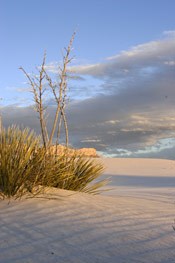
Photo Credit - Dustin Nelson Guadalupe Mountains National Park could easily be described as one of America's best-kept secrets. As if “hidden in plain view," travelers often overlook the park as they drive by. To many, the massive rock face of El Capitan is impressive and forbidding as it stands steadfast in a sea of harsh, barren desert. What else could possibly be here? Or live here? It is easy to mistake the desert’s magic for emptiness, and towering rocks and jagged peaks as treacherous, not worthy of further exploration. But beyond one's first glimpse is an important geological story captured in the rocks and fossils. Guadalupe Mountains National Park preserves one of the finest examples of an ancient, marine fossil reef on Earth. During the Permian period, about 265 million years ago, a vast tropical sea covered much of the region. Within this sea, calcareous sponges, algae, and other lime-secreting marine organisms, along with lime precipitated from the seawater, built up and formed a reef that paralleled the shoreline for 400 miles. After this sea evaporated, the reef was buried in thick blankets of sediment and mineral salts, and was entombed for millions of years until uplift exposed massive portions of it. Today, geologists and scientists come from around the world to study this phenomenal example of a fossilized reef. The biological diversity within Guadalupe Mountains National Park is outstanding and includes more than 1000 species of plants. While many of these are common desert species such as ocotillo and prickly pear cactus, others are found only in the park and nowhere else in the world. Guadalupe Mountains rise sharply from the surrounding desert floor to form an island of outstanding diversity. Several different ecosystems, or life zones, are found within the park. These include the harsh Chihuahuan desert community, lush streamside woodlands of oaks and maples, rocky canyons, and mountaintop forests of ponderosa pine and Douglas fir. Together, these ecosystems provide habitat for 60 species of mammals, 289 species of birds, and 55 species of reptiles. The mountains are also home to thousands of fossils from marine animal and plant life living millions of years ago.
|
Last updated: June 8, 2022
